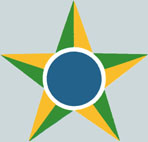
 Força
Aerea Brasileira / Brazilian
Air Force
Força
Aerea Brasileira / Brazilian
Air Force
Roundel Fin flash Credit: Roundels of the world
Last update 21-12-2023
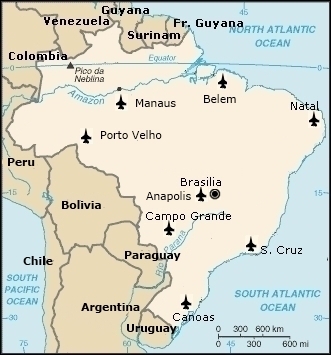
Brazilian_Bases
PROCUREMENT
Brazil expressed for the first time at
the beginning of 1965 interest
to buy 24 Northrop F-5A and F-5B to be delivered starting in 1966, but,
as for so many South American countries, no
export authorisation was
granted by the US government. The Chinese
government offered in 1965 F-7M Airguards (a copy of the
Mikoyan-Gureitch MiG-21-13).
Selection was in preference of Douglas A-4F, SEPECAT Jaguar, HS Harrier
Mk.50 and Fiat G-91. A provisional total of 48 Lockeed TF-33A were instead
bought.
The
country changed its air doctrine from ground attack to air defence of
the whole territorium in 1967, starting with a chain of radars.
Procurement
of a new aircraft to supplant the remaining Lockheed TF-33A used in
the fighter/ground support duties was taken again under consideration
during 1967 and a commission (Commissaos de Estudos
para Aviao de Interceptaçao) was
formed
to find out the best suitable fighter.
According to a local
paper discuusions were held with Canada for the purchase of 15 Canadair
CF-5 to be delivered 1968, without results (probably a fake news as never reported locally).
The Northrop F-5 was evaluated again, sale of which was reluctantly
approved by the US governement due to political issues, but quickly
eliminated due to
insufficent performances. Considered were the
GAMD Mirage III, English
Electric Lightning,
Lockheed F-104G and the Saab J-35. The Mirage IIIE was finally selected
during 1970.
Finally, in
July 1973 was officially announced
the selection
of the Northrop F-5E, after having considered since 1971 the Fiat
G-91Y, GAMD Mirage IIIE, Lightning Mk.55, Saab J-35 and Mc Donnel F-4
(preferred by the Air Force).
A demonstration by F-5E serial 01401 was given on September 1973 at Embraer's factory of Sao José dos Campos. Selected and ordered were additionally 16 Mirage IIID/EBR.
On 30-09-73 a contract was signed with Northrop and in October 1974 36 Northrop F-5E "Tigers" single-seaters
and 6
Northrop F-5B two-seaters
(the Northrop F-5F was not yet built),
without engines and other
equipment, were ordered under the program
"Peace Amazon" at a cost of USD 115m.Though Brazil preferred a
commercial contract to gain procurement and management experience, a
Foreign Military Sales credit
of USD 72.3
millions was arranged for part-payment and further equipment
for 47.7 millions was
acquired separately under direct purchase. They were to equip
2 Esquadraos (Squadrons) at Santa Cruz AB and
1° Esquadrao at
Canoas
AB; two Northrop F-5B were to be attached to each Squadron for
conversion training.
Thirty Brazilian Air Force
personnel worked for more than two years at the Hawthorne plant to gain
experience on latest manufacturing techniques and to maintain Brazilian interests. First Brazilian aircraft was a
Northrop F-5B.
Additional
aircrafts were to be possibly procured to re-equip the 4° GrAv and
the 10° GtAv, but usual budget restrictions made this impossible.
Second thoughts about the purchase of the F-5Bs, due to funding
problems and the Air Forces preference to buy the new Northrop
F-5F for
more compatibility, had aroused in 1974 but US officials convinced the
Brazilians that the aircafts were sorely needed because the majority
of
its pilots were to transit from vintage or low performance vehicles,
like the Lockheed T-33A, the Cessna T-37C and the Embraer T-26
Bandeirante, to the high performance F-5E.
To still save money and
to trimm requirements for ground technicians the FAB decided at the
beginning of 1975 to equip only two Squadrons, both at Santa Cruz AB,
at least for that year.
Air defence was foreseen as main mission, ground attack as
secondary mission. A reconnaissance capability was also foreseen, for which 6 (some sources mention 4) camera
noses were procured, 12 aircrafts had
provision for these noses. The
noses were received in 1975 when they were installed on four Tigers;
a reconnaissance course was given by two expert USAF pilots at
Santa Cruz AB to 1°/14° pilots. The aircrafts
were transferred
to Canoas AB upon completition of the runway remaining at disposal for the 1°/14° Escuadrao, but the idea was to create the 2°/14°
Escuadrao in the same hangar as 1°/14° Escuadrau to operate
the
4 reconnaissance aircrafts. The programm was cancelled, the noses were sold as scrap and the reconnaissance duty was transferred to the Embraer/Aermacchi A-1 based at Santa Maria
On 15-07-75 an off-set deal for a total
value of USD 1.2m covering the
production of 150 sets of tail units and underwing/center-fuselage weapons pylons for Tigers built in USA,
was also signed by the Brazilian
company Embraer,
which
was to undertake all major overhauls of Brazilian F-5's. Discussions
for the possibility of licence manufacture of the entire airframe
as follow-up of the EMB-326 were also held, without exit.

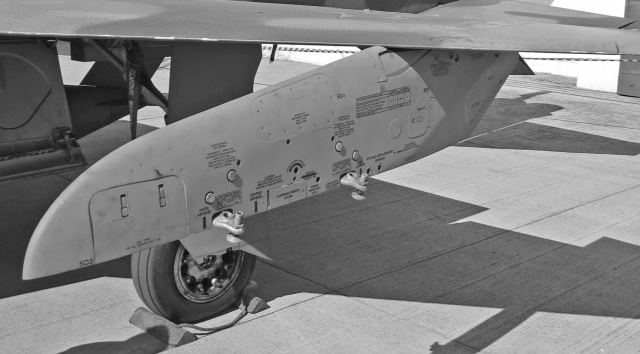 Photo: Embraer
Photo: Embraer
Underwing pylon buit under
licence by Embraer
An
agreement between General Electric and the Brazilian company Celma at
Petropolis (RJ) provided for the overhaul of J-85-GE-13D and -21
engines.
Depot and light overhaul of the aircrafts was to be
performed by the Air Force's Sao Paulo Air Depot, while S. Cruz AB was
to take care of field and light maintanance.
A first group of 5 pilots started training in USA, at Williams AFB with the 425th
Tactical Fighter Squadron, during the summer
of 1974 a complete course lasting six months; other
5
followed during September 1974.
Of these, 6 qualified as instructors to
form a training unit at S. Cruz AB, using F-5Bs. The first intake
completed training by 12-74 having flown around 80 hours. Later Brazilian pilots, sometimes having followed only
a 16 weeks' course and with minimal
F-5 experience, were in charge for the transfer from USA to Brazil.
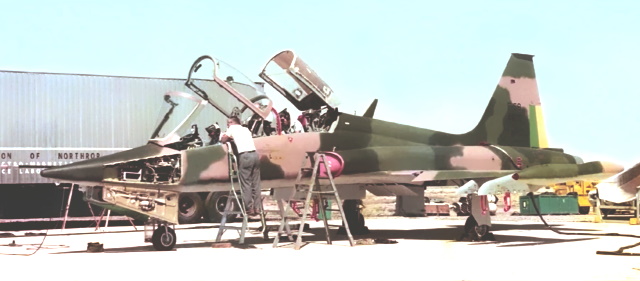
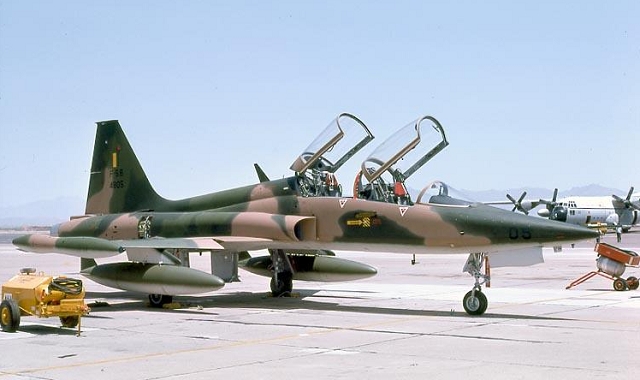
Final
checks at the Northrop Palmdale plant before delivery, Northrop F-5B
4800, of
note
Northrop
F-5B 4805 a Williams AFB in May 1975. Squadron badge is not yet painted
on tail
four underwings pylons and unusual Brazilian flag on rudder.
Palmdale, October 1974
Photo: Archives F-5 Enthisast
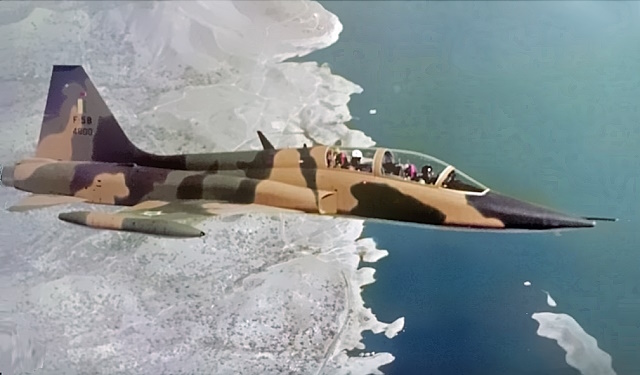 Photo: Embraer
Photo: Embraer
Air-air photo of Northrop F-5B
4800 on tesT in USA, note slightly different camouflage.
On 28-02-75 Northrop handed over the
first 3 F-5B at
Palmdale to the Brazilian AF, arrivals in Brazil began in March 1975, when
the first 3 Northrop F-5B (serials 4800/4801/4802) landed at Galeao AB
on 06-03-75,
followed on 13-05-75 by the final 3 F-5Bs, always at Galeao AB.
The delivery
flight of all Northrops' followed the route Palmdale/Williams
AFB/Kelly AFB/Craig AFB/Homestead AFB/San Juan (Portorico)/Port of
Spain/Panama before finally landing in Brazil at Belem, flying on to
Anapolis
and Galeao Air Base (Rio de Janeiro).
 Photo: Arquivio Nacional Brasil
Photo: Arquivio Nacional Brasil
Arrival ceremony at Galeao AB of Northrop F-5B 4801 on 06-03-75
It operated
initially from there and from July 1975 from Anapolis AB, as the runway at Santa Cruz AB was very short,
barely long enough for the Lockeed T-33A. Transfer to Santa Cruz
AB
was on 03-10-75 when the
runway had been
prolongued to 2'450
meters.
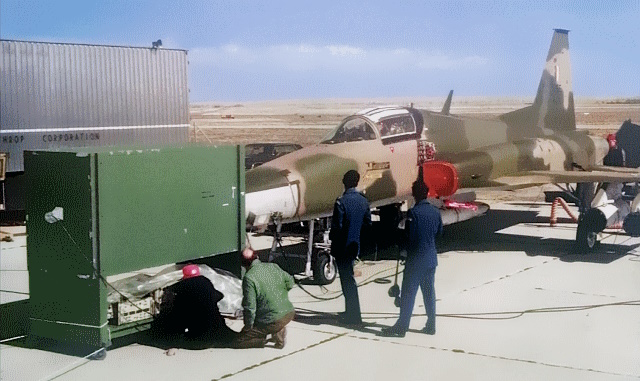 Photo: Northrop
Photo: Northrop
Rockets pod equipped Northrop F-5E during
tests
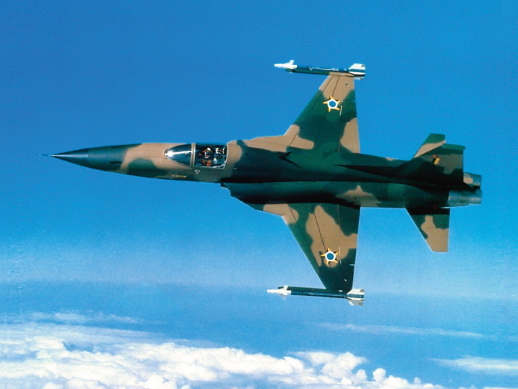
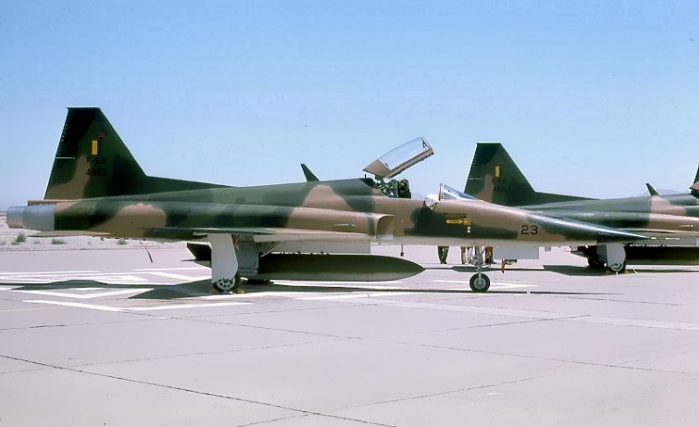
Northrop F-5E serial 4850 seen 1975 in California armed with Sidewinder
AIM-9P Sidewinder Northrop
F-5E 4823 at Williams AFB in May 1975, shortly before
delivery.
(version never adopted by the Brazilian AF),
without air-to-air refuelling probe. Photo: Northrop
Photo: Archives F-5 Enthusiast
Next delivery were F-5E 4850/4851/4852. The first 2 landed
at Galeao AB on 17-06-75
(some sources state there were four aircrafts delivered on 12-06-75) but serial 4852 was lost at Belford Rox shortly before
landing, due to
bird strike.
Further
deliveries followed at approximately four a month until 28th February
1976, when serials 4852 to 4855 safely landed at Santa Cruz AB (some sources state 12-02-76);
delivery were in-flight, starting from
Williams AFB with twelve stops,
including Zandery (Surinam) and Anapolis, ending at Rio de
Janeiro-Galeâo, accompanied by a Lockheed C-130H support aircraft.
See the serials page for additional known delivery details.

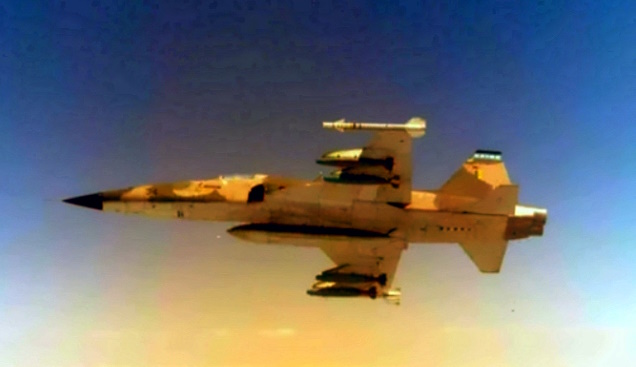
Line-up of first batch Northrop F-5E at Santa Cruz AB Photo: Brazilian AF Northrop F-5E 4834
of the 1°/14° Esquadrao, fully armed with two Mectron MAA-1 and four 500 lbs bombs
Two Lockheed KC-130H were bought to extend the rather limited radius of
action of the Tiger; the F-5E's
were equipped with air-to-air refuelling probes, but only 13 probes
were fitted in USA, the rest in 1976 after
arrival in
Brazil.
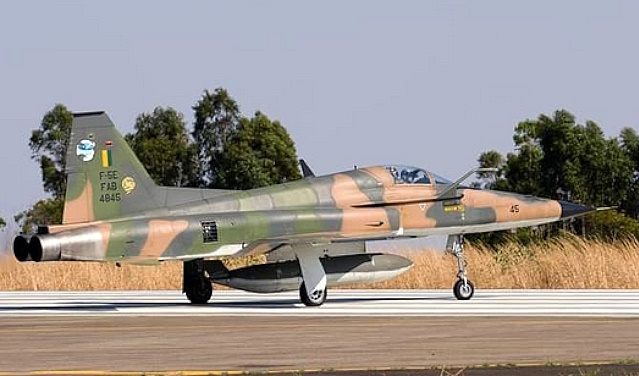 Photo: Brazilian AF
Photo: Brazilian AF
First batch serial 4850, first camouflage, on take-off, 100 years anniversary patch on tail
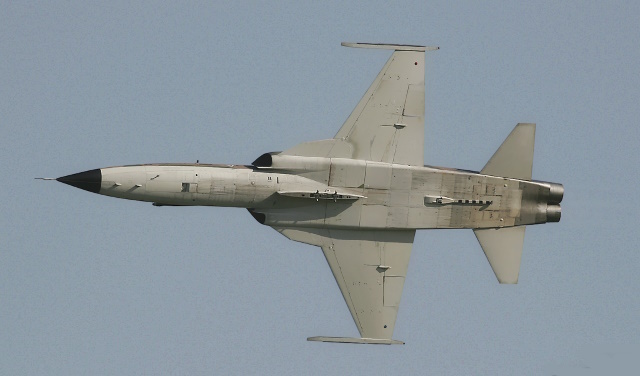
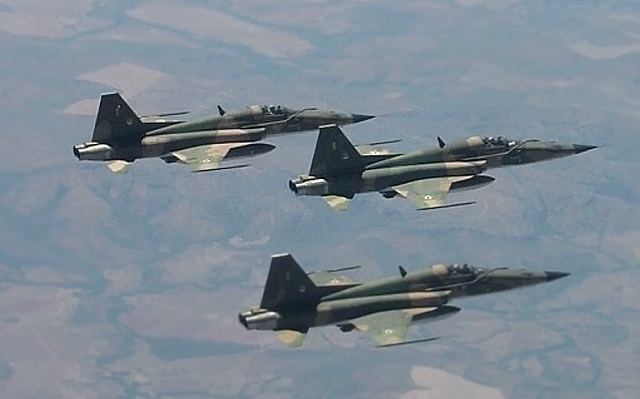
Underfuselage of same aircraft seen at Campo dos Alfonsos AB on 15-10-06
Overwing view of 3
Northrop F-5E in formatin flight, first
batch Photo: Brazilian AF
Photo: Guilherne Bystronski
An
Chilean offer (unconfirmed and denied by Chile) to transfer its own
F-5Fs in exchange for Brazilian responsability to train Chilean F-5
pilots was not accepted as politically unacceptable due to Chilean
human rights
policy.
The acquisition of additional second-hand aircrafts was taken into consideration during 1980, without follow-up. A Chinese barter offer of CAIC F-7 each in exchange of 2 Embrer Tucano each during the 1980's was not
accepted.
It
is interesting to know that Embraer studied during th 1980s the
development of a supersonic fighter/trainer called "project MFT-LF"
(Multi Functional Tactical - Llight Fighter) with similar performances to the
Northrop F-5E, both to re-equip Brazilian fighter units and to replace the Embraer MB-326s trainers used as attack aircrafts and trainers. No partner could be found to share the costs of development and the project
was not realised.
On
28-12-85 an unexpected announcement from Brasilia revealed that
approval had been given for the procurement of a further Northrop
F-5E/F to make good attrition and in order to concentrate all
"original" aircrafts
at Santa Cruz AB. These were to be completely
refurbished aircrafts.
An appealing offer was received from South
Korea, where the airframes would have been modified to zero time and
updated to latest standard, but unfortunately not accepted due to costs
problems. Further investiga-
tions to obtain lower priced fighters led to
the evaluation of Chinese F-7M Airguards and Mirage III from several
sources, all dropped for various reasons.
The
US government offer in 1988 for 22 F-5E and 4 F-5F for USD 113.5m (named programm
"Peace Amazon II") was successful. Eleven of these came from former USAF
aggressor Squadrons in USA, whose disband-
ment was started in August
1988 and completed in April 1989, and fifteen from the 425th Squadron,
disbanded in April 1989. They were not equipped with an air-to-air refuelling probe. The aircrafts were used first to
train Brazilian pilots in USA. The Air Force was also interested in using 8 of the machines in the reconnaissance role, but this was not realised.
The first five departed from Nellis AFB on 29-09-88, the last ones on 23-08-89, all from Homestead AFB with final destination Canoas AB in five waves. Brazilian pilots ferried them in 8 stretches, supported by a KC-137
precious to keep
contact with the civilian air traffic authorities along the route as
the fighters were not equipped with VHF radios.
The fourth wave left end April 1989 and was formed by Northrop F-5E FAB
4858, 4861, 4871, 4873 all in original Air Defence Command colours;
they arrived Canoas AB on 10-05-89 (due to some mishaps on route)
flying from AFB Homestead to Nassau/Roosevelt Roads/Ilha Margarita
(Venezuela)/Boa Vista (Brazil)/Manaus/
Belém/Fortaleza/Salvador/Rio de Janeiro/Canoas.
Unfortunately these "new" aircrafts were in poor conditions, needed a
thorough overhaul and the installation of a VOR, GPS and VHF radio.

The last Northrop F-5F, serial 4809, seen in USA with its former serial
(40457) at
Williams AFB in August 1989.
Photo: Archives The Northrop F-5
Enthusiast

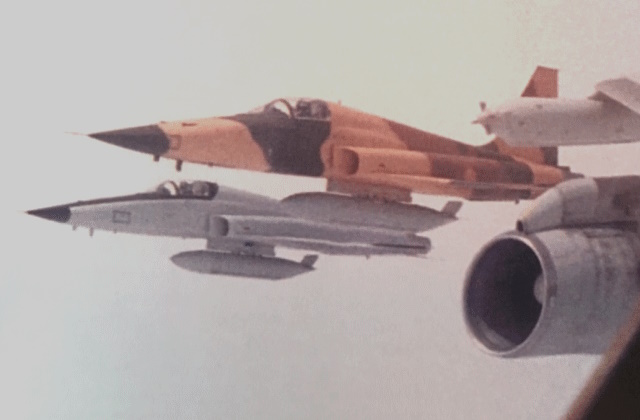 Photo: FMagalhes
Photo: FMagalhes
F-5E
with dual Brazilian/USAF serials 4859/1386 at Williams on
14-04-89. Second batch Northrop F-5Es seen from the accompanying Boeing KC-137 (with a-a refuelling
Photo: archives The Northrop F-5 Enthusiast pod) on delivery flight, still in USAF colours, but with Brazilian serial.
All
"new" aircrafts went to the 1°/14° GAv at Canoas AB (Porto
Alegre), the only Tiger Squadron now exclusively tasked with air
defence, though the basic Emerson APQ-153 radar was of limited value.
The "original"
aircrafts were returned to the 1° Grupo de
Caça.
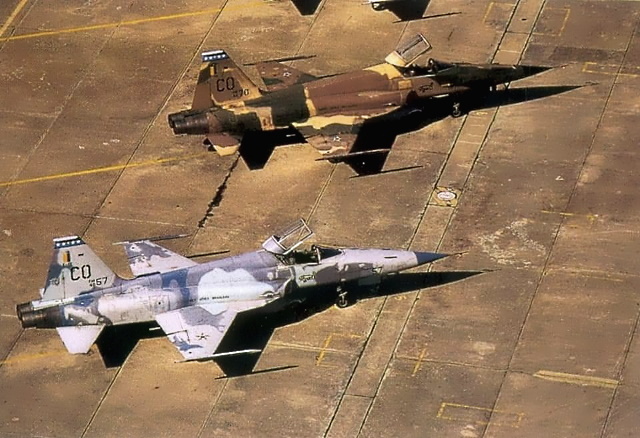 Photo: unknown
Photo: unknown
Northrop F-5
4857 4870 in original USAF colours, as delivered, in use by the 1°/14°
Esquadrao.
Short range for the enorm Brazilian county was always a problem for the Northrop fighter; purchase of air-to-air refuelling aircrafts helped to lessen the problem.
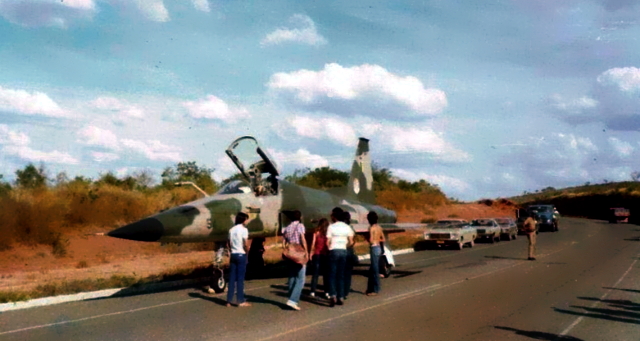 Photo: unknown
Photo: unknown
Northrop F-5E 4854 of the Primero Grupo de
Aviacào de Caça on 14-08-80 after its
emergency
landing on a road in the
State of Minas Gerais
Simulator
A
former GE Training Center Compuscene III simulator with visual display
dome was bought at the beginning of the 1990s to lower training costs,
keep airframes flying hours and maintenance costs low.
Northrop F-5B saga
Operation of the early Northrop F-5B was slowed downwhen the more advanced F-5F were received.
By the end of July 1995 only 2 F-5B remained operational. The last Brazilian Northrop F-5Bs were withdrawn
from use on 22-05-96; they were all up for sale and transferred to Campo de Marte for storage.
A
rather unhappy story followed. Former Brazilian AF colonel Gustavo
Adolfo Franco Pereira bought the 5 aircrafts at an auction in 1996 for the
price of USD 3.1 millions and paid a deposit of 155 millions Reals,
trans-
action financed by an American friend, Richard Boulais. Mr Pereira
even bought an hangar at Canpo de Marte to store the trainers. The
auction was cancelled auctions, a direct sale was also done
and again cancelled;
the aircrafts were never handed over to the
(almost) new owner.
The main problem was the "end user certificate"
required by the USA as the aircafts were of US origin, need for which
the buyer didn't recognise, as the US law regarding it was approved in
1976 while the aircrafts
were bought by Brazil in 1973.
In the meantime the two-seaters had lost
their serials and any inscription, were coded from 1 to 5 and
repainted, with the upper surfaces dark grey, the lower surfaces in
clear grey.
They were used as mobile static exhibition objects, as shown on this picture taken at Campo de Marte on 23-10-05.
Photo: spotter.com.br
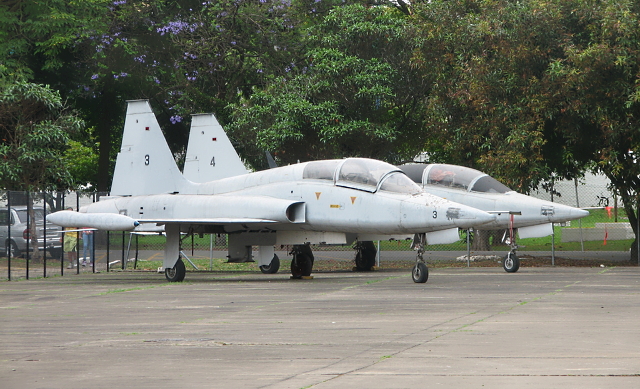
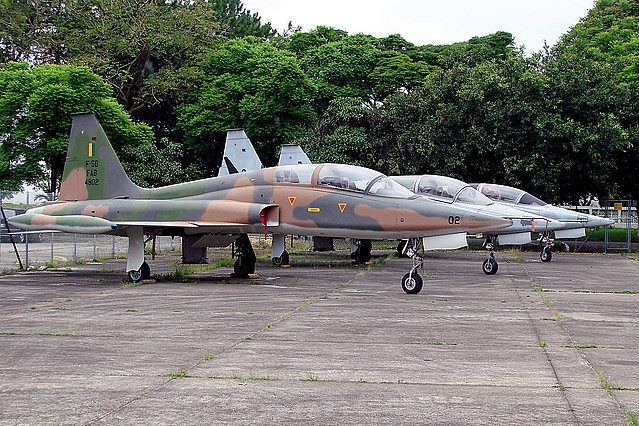
All aircraft were temporarely stored at Campo de
Marte, serials 4 and 4 seen here on 24-10-10. Serial 4802 already repainted in the original camouflage together with older, all grey ones
Photos: Ricardo Hebmuller
Mr
Pereira discussed its rights as owner with the Air Force ever since
1996 when
unsecsful sale was foreseen by USA broker as FOB Mojave, total less
than 2600 hours total time, Disassembled and professonally
crated,
engines not included, military aviionics, all weapons and weapons
systems removed prior to delivery.
He applied in December 2006 to the Brazilian justice to obtain
either the aircrafts or refund of his down-payment. The Federal Court
finally judged that the aircrafts still belonged to the Air Force
and they were
put on exhibition at various places.
Fate
of others are known: serial 4802, camouflaged, as a travelling
exhibit; 4804 mountd on a pole in Rio de Janeiro-Galeao airport; serial 4805 at Santa Cruz AB mounted on a pole, camouflaged.
Fleet upgrading and search for additional aircrafts
A new project regarding the
rest of the fleet was launched during the year 2001: upgrading the
available aircrafts to a fourth generation fighter standard; this
resulted in the Embraer/Northrop F-5EM and F-5FM
models.
You can read
details of the project under the Northrop F-5 Enthusiast page titled upgrades.
The
Air Force also realised that the number of trainers (3
F-5F) was insufficent for conversion and refresher training of new and
old pilots.
As the Embraer/Aermacchi EMB-326 was officially withdrawn from use on
02-10-10 new pilots passed directly from the Embraer A-29 Super
Tucano to the Embraer/northrop F-5FM, necessitating an greater number of this last.
Additional new aircrafts (both in double- and singleseater
form) were to be operated by a new Operational Conversion Unit. During
the year 2002 it looked among other F-5 operators for the best
aircrafts available
for sale.
A first offer of Saudi Arabian Tigers by Boeing, demanding the purchase of 2 F-5Es for every F-5F purchased was rejected. Swiss
top maintained Northrop F-5Es were also up for sale, but no F-5F was
available. Help
came from Northrop/Grumman's subsidiary Tiger Century
Aircraft which had already projected to convert China/Taiwan AF single-
to double-seaters and offered to convert 8 of the 16 Swiss aircrafts
into two-seaters.
Memorandums of Understanding were signed on
30-09-02 and 15-10-02 between the Swiss "Gruppe für
Rüstungsdienste" (Armament Group) and the Brazilian AF. Price for
each aircraft was to be USD 0.5m "as-is".
The Brazilian AF cancelled,
in a change of mind, the plan to modify single- to two seaters and
requested on 14-01-03 the sale of Swiss F-5Fs. An offer for 2 F-5Fs and
14 F-5Es was of no interest to the Brazilian side.
Finally, on
01-04-03, a new search for 8 F-5F airframes was started with Singapore,
Korea, China/Taiwan as well as Saudi Arabia.
Three Northrop F-5F and
six F-5E from Saudi Arabia were selected and a
contract was signed on 29-12-05 between the Brazilian Aeronautical
Commission in Washington and the company C&C International, acting
as
a mediator, for the price of USD 24m to be paid in three instalments
of USD 10m in 2006, USD 13m in 2007 and USD 1m in 2008. Brazilian
pilots were to fly them from Riyadh to Recife via Dakar and other
stations.
No information about the status of the deal or the arrival
in Brazil of these aircrafts was given until the end of September 2009,
when, surprise!, an official announcement informed that a contract had
been signed for
the acquisition of 4 Northrop F-5E, 4 F-5EM (which had
received locally a limited upgrade) and 3 Northrop F-5F from Jordan for USD
21m, through the mediator Jordan Aeronautical Systems Company.The
announce-
ment gave also information about the cancelled Saudi purchase:
the aircrafts were in poor condition; there was difficulty in obtaining
"end-user" certificate needed according to the original pruchasing
contract and the
possibility that these planes might not be available,
as they were part of the new Saudi Eurofighter purchase contract.
A
first batch of 3 F-5Es arrived at Sao Paulo-Guarulhos
airport on 19-08-08 on board an Volga-Dnepr Air Lines AL
An-124-100, still in Jordanian colours, together with several spare parts, inclusive wing
tanks; all
were transferred to Campo dos Alfonsos AB for maintenance. It
was planned to invest 276 millions Reals for modifications, in order
to keep them operational at least for another 15 years.
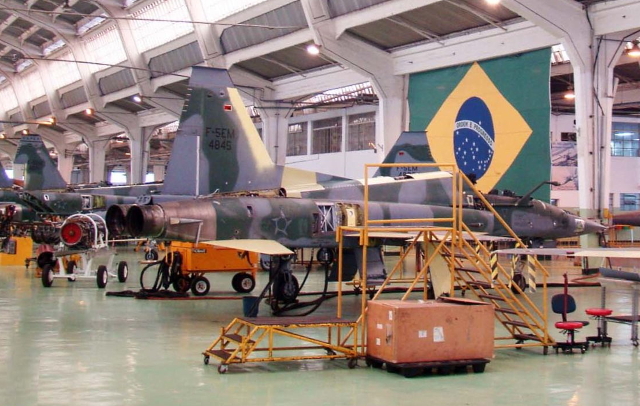
Former Jordanian
Northrop F-5E still in desert camouflage, with last two of Brazilian
serials,
almost unreadable Jordanian and USAF serials at PAMA Campo dos Alfonsos
maintenance base
Parque Material Aeronautico de Marte provides
full structural and systems maintenance/overhaul on the Tiger, while complete
General Electric J-85 engine maintenance has been undertaken since 2002
by Focal (RJ).
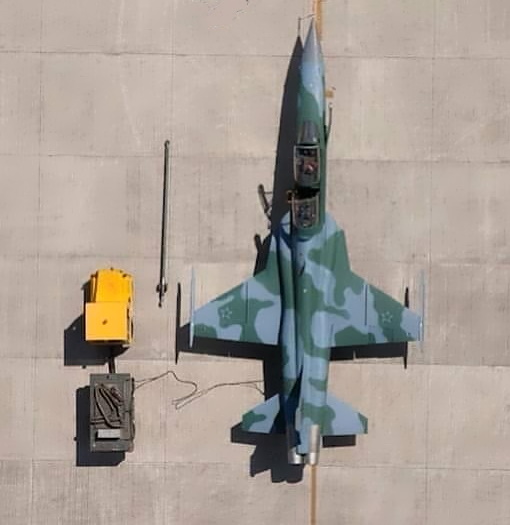
By the end of 2012 18 Tigers had been upgraded.The
46th and last first batch upgraded Northrop F-5EM was delivered
to Santa Cruz AB,
on
07-03-13; contract to upgrade the former
Jordanian aircrafts was signed in 2012. The first ex Jordanian single-seater
was delivered
to
Brazil in October 2013, while 2 double-seaters were delivered in
November 2016.
Defence of the Northern region aound the capital (Brasilia) was assured by some Embraer/Northrop
F-5s from other
bases, redeployed
to Anapolis AB when the early retirement took place (the end of 2013)
of the Mirage 2000s used by the 1°
Grupo de Defensa Aerea at
Anapolis AB
(Brasilia). The mentioned Tigers
remained until the local pilots were re-trained on the
Embraer/Northrop F-5EM and some own
aircrafts were delivered.
Photo: Overfuselage/wings view of an Embraer F-5EM in new camouflage.
In 2011 it was decided that only
three of all the eleven former Jordanian Northop F-5E/F were to be
upgraded to Embraer/Northrop F-5FM standard, due to operational
and budget
(mainly) reasons. Only one
two-
seater had been delivered in
October 2014, additional two Embraer/Northrop Embraer/Northrop F-5FM were received in October and November 2017. Most former Jordanian single-seaters were used as replacment,
pieces, some as museum exhibit (e.g Museu Aerospacial at Rio de Janeiro).
Photo: www.aereo.jor.br
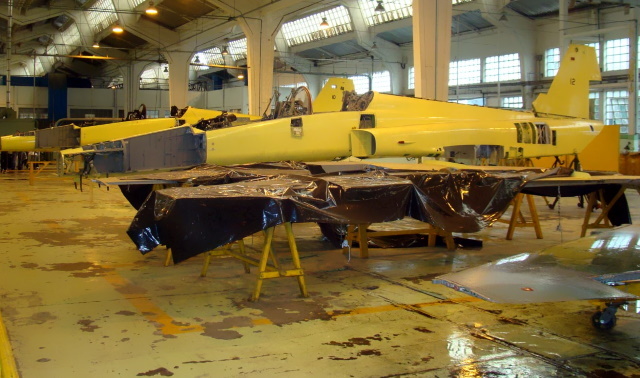
The
last (serial 4812) former Jordanian Northrop F-5F
being worked on at PAMA Sao
Paulo
on 16-10-11. In the background single-seater 4810.
Retirement
(as of 2012) of the first Embraer/Northrop F-5EMs was planned by 2017 but indefinitely postponed, possibly till 2028. In the meantime TAP Manutençao
e Engenheria Brasil takes care of base level
inspections/
maintenance of the Tigers; the first was delived to the company at the end of 2013 and re-delivered to the Air Force on 24-03-14 at Campo de Marte AB (PAMA SP) after having received the 600 hours inspection.
The
Argentinian newspaper "Clarin" mentioned in August 2017 known contacts
by Argentina and Brasil for the transfer of Embraer/Northrop F-5EMs
for a certain period, but this was denied by the Brazilian Air Force.
Embraer
completed its Tiger upgrade programm on 16-10-20 with the delivery of
the last aircraft (former Jordanian, local serial now 4810, see
below), at Embraer's facility at Sao José dos Camps on 16-10-20. It was destined
to the ALA 3 at Canoas AB,
Esquadrao Pampa, and transferred to its base on 21-11-20.
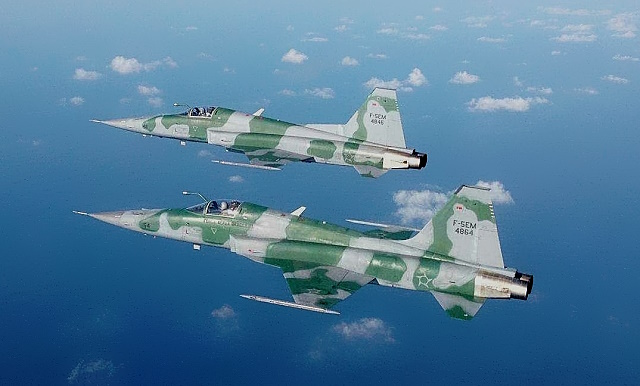 Photo: Brazilian AF
Photo: Brazilian AF
Embraer/Northrop F-5EM 4864 and 4836 without Squadron markings flying over the sea
Three former Jordanian Northrop F-5E (partially refurbished). serials 4878/4880/4884 were sold to the consulting company Aerosuport, based at Rio de Jneiro for the price of USD 29'000. Only the fuselage and
some parts of wings and stabilizer were on offer (prices varying between USD 5'000 and 11'000).

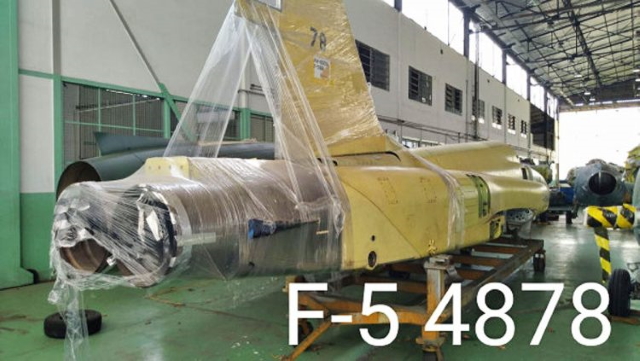
Fuselage of aircraft Embraer F-5BR
/AV-0050(?) and former Jordanian, serial
4878, on
date of auction
Photos: Joao Emilio
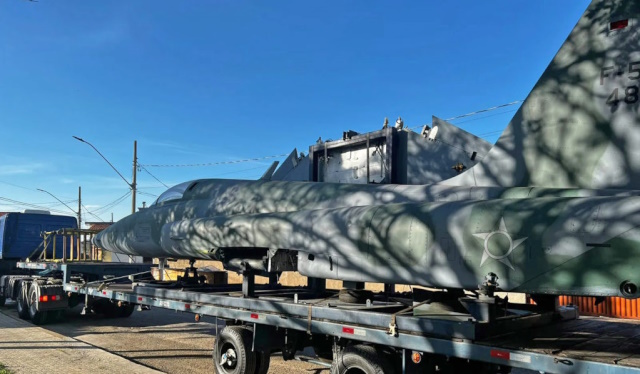 Photo: Prefetura de Carandai/MG
Photo: Prefetura de Carandai/MG
Sad end of prototype F-EM serial 4874,preserved, on trailer on the way to
Rosario/Carandai arrving on 21-11-22
Many more details are given in the book: NORTHROP F-5 NO BRASIL -1st edition 2011, 2nd edition 2018
BY LEANDO CASELLA AND RUDNEI DIAS DA CUNHA
Embraer/Northrop F-5 replacement aircraft
The Embraer/Northrop F-5 and Embraer AMX/A-1 replacement programm, known as F-X2 competition,
was launched in 2007. Participating
to the long evaluation were Boeing FA-18E/F Super Hornet, Sukhoi
Su-35,
Dassault Rafale
FJR, Saab JAS-Gripen NG. This last (local designation F-39) was announced as winner at the end of 2013, mainly due to commerial reasons and transfer of technology to Brazilian industry. Twenty-eight
Gripen E asingle
seaters and 8 Gripen F double-seaters
were ordered initially flew for the first
time on 26-08-19, as seen hereunder. The last is
foreseen to be delivered in 2024. It first flew from Brazil on
24-09-20;
iinitial deliveries equip the 1° Grupo de Defensa Aerea (GDA) at
Brasilia/Anapolis AB) here were the Saab F-39 concetrated.First four delivered was is foreseen in December 2021, starting to replace Embraer/Northrop F-5EM.
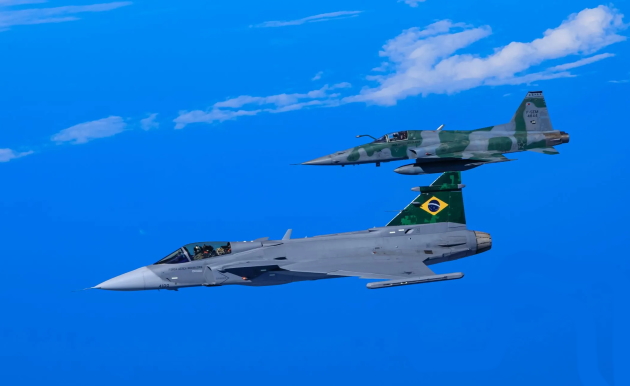
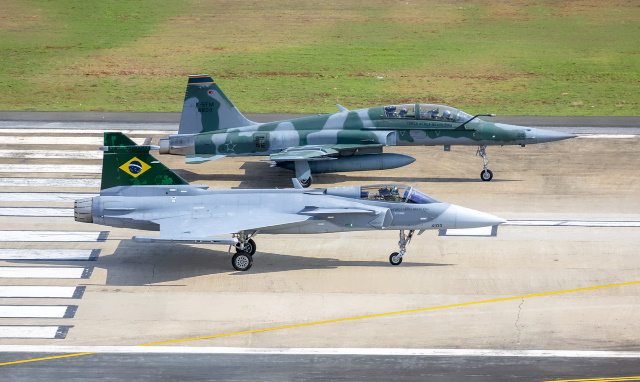
In-flight photo in Brazilian sky of first Brazilian F-39 with Embraer F-5EM
Old and new generation:
simultaneous take-off from Brasilia of Embraer F-5FM and Saab
F-39
Photo: Brazilian AF/Sgt Johnson
Photo: Brazilian AF
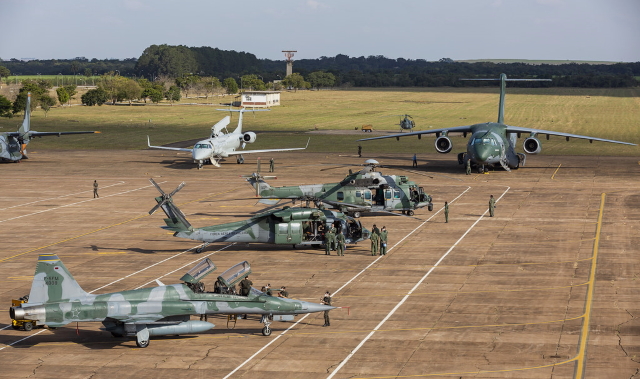 Photo: Brazilian AF/ Sgt. Bianca
Photo: Brazilian AF/ Sgt. Bianca
Line-up of first line Brazilian AF aircrafts/helicopters; missing are Lockheed P-3 and Embraer A-1.
Four Embraer/Northrop F-5EM had been been withdrawn from use by
March 2021; one Northrop F-5EM of the 1° Grupo de Aviacion de
Combate made
an emergency landing at S. Cruz AB on 31-05-21
suffering considerable
damages were being withdrawn from use.
By
the end of 2021 there were 47 Tigers available, around 38/40 were
operational; the rest was on maintenace. Information stated that by
beginning of April 2022 seven aircrafts were stored at PAMA Sao Paulo,
without
plans to return them to operation; of these 6 were single-seaters
(1 former Jordan, 5 of the second (first) lot received) and one
double-seater. These aircrafts included the first ever built Northrop
F-5E,
Brazilian, serial 4874, and the Northrop F-5F serial 4806 whichhad an accident at S. Cruz AB on 05-07-16.
The Tiger equipped 1° Esquadrao/4° Grupo de Aviaçao "Pacau" was dissolved on 17-12-21, with the arrival in Brazil of the first two Saab F-39E (J-39E Gripen) on 01-04-22, delivered to the Centro de Ensaios em
Voo do Gripen (Gripen Flight Test Center). Apart for Manaus AB a second Air Base is also foreseen to be equipped with Saab F-39 based,
probably where at present Northrop's F-5s are operational. Two additional
Gripen fighter are expected to be delivered during the first half of 2022.
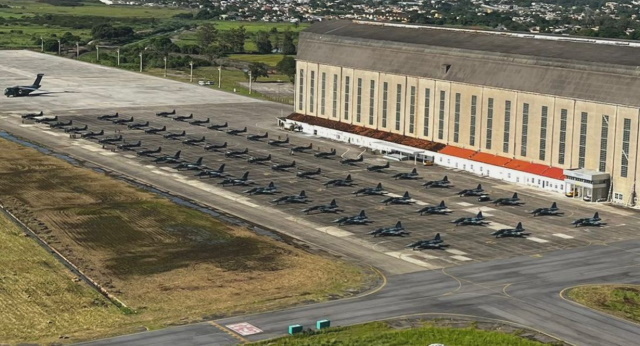 Photo: Brazilan AF
Photo: Brazilan AF
Impressive line-up on 22-04-22 of 18 Embraer F-5EM, F-5FM at S. Cruz AB with Embraer A-1 (AMX) and
S. Tucano for the "Dia da Aviaçao de Caça".
In the background the
enormous "Zeppelin" airship hangar.
Seen at PAMA Sao Paulo on 11-06-22 one Embraer/Northrop F-5E (serial
4871) possibly withdrawn from use (or awaiting maintenance). It has
markings of the 1°/14° GAv. A total of seven aircrafts
are to be initially withdrawn from use, inclusive 1 former
Jordanian, 5 from the first lot, the prototype
Embraer/Northrop F-5EM serial 4874 and Embraer/Northrop F-5FM damaged in a landing
accident.
First operational air-to-air refuelling excercise by 2 Embraer/Northrop
F-5EM of the 1° GAvCa and and the new Embraer KC-390 (serial 2857) of the 1°
GTT took place on 09-08-22 in the Rio
de Janeiro area.
Fourteen Northrop F-5s, 4 of
which withdrawn from use, some prepared for withdrawal, some
others in maintenance, were seen in October 2022 at PAMA Campo des Alfonsos.
Maintence of the GE J85-21C takes place in 2020 at PAMA Sao Paulo.
Retirement plans for the Tiger from 2022 till 2029, were as follows:
2022 - fleet 43 aircrafts, withdrawn from use: 8 aircrafts - operational: 28 aircrafts, flown 4'300 hours
2023 - fleet 35 aircrafts, withdrawn from use: 3 aircrafts - operational: 26 aircrafts, flown 4'230 hours
2024 - fleet 32 aircrafts, withdrawn from use: 4 aircrafts - operational: 23 aircrafts, flown 3'500 hours
2025 - fleet 28 aircrafts, withdrawn from use: 2 aircrafts - operational: 20 aircrafts, flown 3'100 hours
2026 - fleet 26 aircrafts, withdrawn from use: 3 aircrafts - operational: 16 aircrafts, flown 2'430 hours
2027 - fleet 23 aircrafts, withdrawn from use: 3 aircrafts - operational: 14 aircrafts, flown 1'900 hours
2028 - fleet 20 aircrafts, withdrawn from use: 6 aircrafts - minimum aircrafts foreseen operationall: 10 , flown 1'370 hours
2029 - fleet 14 aircrafts, withdrawn from use: 14 aircrafts - minimum aircrafts foreseen operational: 8, flown 1'000 hours
TOTAL fleet hours foreseen before withdrawal: 21'830 hours.
The first Tiger replacement fighter, in the form of operational Saab F-39 serials 4103 and
4104, arrived at Anapolis AB on 29-11-22; official ceremony for
hand-over to the unit was on 19-12-22.
The two Gripen were delivered on 05-05-23 to Anapolis AB.
One Northrop F-5FM (serial 4806) and seven Northrop F-5EM (4826,
4837,4848, 4849, 4850, 4851, 4852) were in March 2023 at PAMA-Sao
Paulo. Almost all are first lot aircrafts, plus second lot
ones (4856, 4857, 5858).Other aircrafts of the first batch, bought directly by
Brazil/modified to Northrop F-5EM (and written-off) configuration, are
kept in use but foreseen to be retired according
above schedule.


 Força
Aerea Brasileira / Brazilian
Air Force
Força
Aerea Brasileira / Brazilian
Air Force

 Photo: Embraer
Photo: Embraer

 Photo: Embraer
Photo: Embraer Photo: Arquivio Nacional Brasil
Photo: Arquivio Nacional Brasil Photo: Northrop
Photo: Northrop



 Photo: Brazilian AF
Photo: Brazilian AF



 Photo: FMagalhes
Photo: FMagalhes  Photo: unknown
Photo: unknown Photo: unknown
Photo: unknown




 Photo: Brazilian AF
Photo: Brazilian AF

 Photo: Prefetura de Carandai/MG
Photo: Prefetura de Carandai/MG

 Photo: Brazilian AF/ Sgt. Bianca
Photo: Brazilian AF/ Sgt. Bianca Photo: Brazilan AF
Photo: Brazilan AF